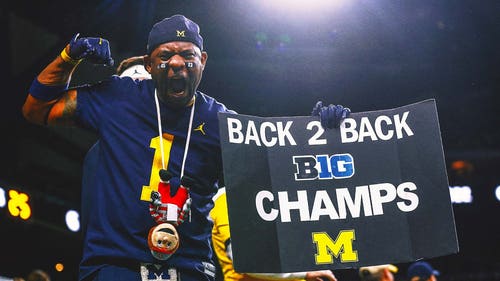
New Lawrence Phillips documentary a powerful, tragic portrayal of ex-Huskers star
When Ross Greenburg noticed the death of Lawrence Phillips, the former Nebraska running back legend and troubled NFL player, the esteemed director remembered the first incident—Phillips’ assault of Nebraska basketball player Kate McEwen—and the subsequent violence that followed one of the most physically promising, but serially violent players of the past 25 years. With a wife who interviews child abuse victims and a daughter who works as a domestic violence advocate, Greenburg was long intrigued by Phillips, and disheartened by the suicide of a figure whose star-studded collegiate career led to incarceration instead of glory. While Phillips’ legend looms at the University of Nebraska because of his decorated career and his bruising running style, Phillips’ legacy is one of a player who reached the heights of glory before a descent into a life of violence. Why revere or excuse an individual who received a second chance from his college team, third, fourth and fifth ones from NFL squads, despite a reprehensible pattern of violence primarily against women?
Then Greenburg researched Phillips’ life and discovered the running back’s neglected childhood, how admired he still was by former friends and teammates, and the mysterious circumstances of his tragic January death in California’s Kern County Prison. Greenburg figured it was an opportunity to contextualize Phillips’ life, pummel the audience with its depressing tale, and challenge it to fight for societal change.
But this was going to be a difficult figure to humanize. Many remember watching Phillips’ majestic upright running style when he led the Cornhuskers to back-to-back national titles. They likely read about his crime-ridden life soon after the glory ended. Greenburg decided viewers needed a reminder of Phillips’ life, even if it makes for two agonizing viewing hours.

The result is Running for His Life: The Lawrence Phillips Story, a layered documentary that encompasses themes of child abuse, the inadequacy of state-run foster care, the lionization of star football players, violence against women, alcoholism and the perils of incarceration. It runs on Showtime on December 16th.
“The basic assumption is that here goes another millionaire athlete throwing his life away,” Greenburg says. “I thought it was time to take a deep dive into somebody’s life like Lawrence to determine the reasons why. Upon further research, his life captured the further sociological problems in American life.”
In a year where O.J.: Made in America will drown out any documentary attempting to explore the ties between football fame and domestic violence, Running for His Life treads some of the same territory with the backdrop of childhood abandonment. The opening of the film spans Phillips’ violent upbringing in Los Angeles: He suffers abuse by his mother’s boyfriend, he runs away from home, he relocates to a violent and poorly managed state-run foster home in the suburb of El Monte, and he eventually settles in a nearby West Covina group home run by a benevolent social worker named Barbara Thomas. All of this happens before age 12. The brooding rage from his neglected childhood fueled him as a star football player at Baldwin Park High and Nebraska, but eventually manifested itself in repeated violent episodes throughout the course of his life. Romantic partners—or unwilling ones—were usually his victims.
Phillips’ assault of McEwen, one in which he broke into a teammate’s apartment and dragged his ex-girlfriend down a flight of stairs, is the film’s most applicable story for a problem that has hounded college and professional football over the last several years. Football’s popularity is partially responsible for thrusting the plague of domestic violence into national focus; “the Ray Rice video” is now everyday parlance, and the Cowboys’ signing of Greg Hardy prompted universal criticism after charges of strangling his girlfriend and throwing her onto a pile of guns (the charges were expunged from his record after the victim failed to appear in court). Phillips was initially dismissed from the team after assaulting McEwen, sent for psychological evaluation, and controversially reinstated after a de facto six-game suspension.
Nebraska head coach Tom Osborne, a devout Christian and the most revered college head coach at the time, insisted that reinstatement was necessary because the football team was Phillips’ lone semblance of structure. Much like the Cowboys’ signing of Hardy or Oklahoma’s refusal to dismiss (instead suspend) star running back Joe Mixon after punching a woman in the face, Osborne’s decision was one of the first high-profile choices that reeked of opportunism—even if the coach was considered a figure of unimpeachable character. Phillips was the best player on the defending national champion; one wonders if a less talented player, regardless of his upbringing, would have received such clemency. Osborne was derided for bringing Phillips back, and his press conference featured cringeworthy equivalence (he compared his decision to a famous two-point conversion), but still defends the choice as one that was best for Phillips.
By revisiting the incident, Running for His Life showcases the legendary coach’s concern for Phillips’ well-being, but proof that coaches will justify violent crime under the guise of “protecting the player.” Osborne’s testimony in the film reveals a genuine concern for his troubled and erratic star, but while Phillips anchored Nebraska’s run to a second consecutive national title, McEwen would lose her basketball scholarship and eventually leave the university. Like so many high-profile abuse cases involving athletes, the star usually is offered a chance to rehabilitate his image. The fate of the victim is often unknown or forgotten.

Once Phillips left Nebraska, his rocky tenure in the NFL and outside of it (NFL Europe, CFL) was marred by heavy drinking, more violence against women, and a clear indication that he’d never right his path despite numerous second chances. The Dolphins picked him up from the Rams, but cut him after a woman claimed Phillips struck her in a bar. The 49ers signed him after his successful stint in NFL Europe, but his lazy play and fraught relationships with coaches and teammates led to his release. He would go onto to assault another woman while playing in Montreal before retiring in 2003.
Dick Vermeil, Phillips’ coach on the St. Louis Rams, agonizes over his choice to release Phillips after he showed up to a game hung over. Others—including former teammates Steve Young, D’Marco Farr and a host of Nebraska players—recall a well-meaning but irresponsible man. As his life spiraled from troubled to completely chaotic after his football career, the portrait of Phillips as a good man haunted by internal rage becomes increasingly difficult to accept. The testimony of ex-girlfriend Amaliya Weisler, the most engrossing and harrowing interview of the film, showcases Phillips not as a troubled man, but a terrifying serial abuser. Incredibly, Weisler still speaks to the best parts of Phillips’ personality and would eventually write letters of recommendation describing him as a big-hearted and misunderstood. She did so despite suffering strangulation marks that, according to her attorney, were “the worst I’d ever seen on a living victim.” Every interviewee who speaks on behalf of Phillips insists he was repentant anytime his anger overtook him, but the sheer amount of incidents indicate that a seemingly earnest apology may have been a convenient defense mechanism. The 32-year prison sentence he’d receive for attempted murder after he ran over a teenage boy as well as his assault of Weisler was a sad, but seemingly inevitable conclusion to his tumultuous life after football.

Perhaps Phillips truly was repentant. Those who visited him in prison saw a broken man who managed a glowing smile when received by a familiar face. The end of the film steers into part Lockup, part murder mystery and part heavy-handed plea on the importance of saving America’s youth. There’s a hollowness to the message; Phillips’ trouble with the law and penchant for violent crime can’t be entirely attributed to his troubled upbringing, but every interviewee agrees it was one of the primary factors. The depressing conclusion to his life—he was found hanging in his cell shortly after being charged with the murder of his cellmate—is spun into a sermon designed to warn of the dangers of neglecting children, even if they escape their predicament to reach the heights of fame like Phillips.
By the film’s end, Osborne laments that there are several Lawrence Phillips's out there—deserted, abused and without a future. Greenburg admits that when he made the film, the goal was to make viewers sad and to prove that certain figures can’t outrun a horrifying past. He succeeds, but Phillips’ penchant for violence against the vulnerable and defenseless hardly makes him sympathetic—even if his childhood and fate were circumstances that nobody should experience.



